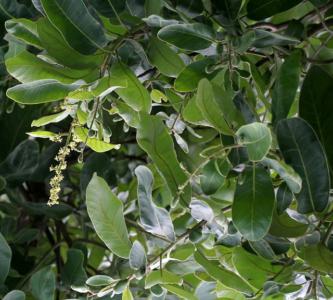Semecarpus anacardium
(Semecarpus anacardium)

Description
Semecarpus anacardium is a native of India, found in the outer Himalayas to Coromandel Coast. It is closely related to the cashew. It is known as Bhallaatak in India and was called "marking nut" by Europeans, because it was used by washermen to mark cloth and clothing before washing, as it imparted a water insoluble mark to the cloth. It is also known as Gudde Geeru in Kannada and bibba in Marathi and Jeedi Ginja in Telugu. It is a deciduous tree. Like the closely related cashew, the fruit is composed of two parts, a reddish-orange accessory fruit and a black drupe that grows at the end. The nut is about 25 millimetres (1 in) long, ovoid and smooth lustrous black. The accessory fruit is edible and sweet when ripe, but the black fruit is toxic and produces a severe allergic reaction if it is consumed or its resin comes in contact with the skin. The seed inside the black fruit, known as godambi is edible when properly prepared.
Taxonomic tree:







